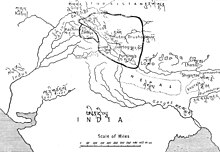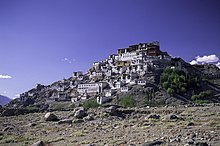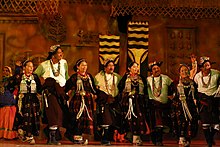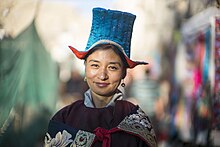Ladakh
[2] Ladakh is bordered by the Tibet Autonomous Region to the east, the Indian state of Himachal Pradesh to the south, both the Indian-administered union territory of Jammu and Kashmir and the Pakistan-administered Gilgit-Baltistan to the west, and the southwest corner of Xinjiang across the Karakoram Pass in the far north.[11][12] The eastern end, consisting of the uninhabited Aksai Chin plains, is claimed by the Indian Government as part of Ladakh, but has been under Chinese control.[21] Ladakh was established as a union territory of India on 31 October 2019, following the passage of the Jammu and Kashmir Reorganisation Act.[31] Xuanzang's term of Ladakh is Mo-lo-so, which has been reconstructed by academics as *Malasa, *Marāsa, or *Mrāsa, which is believed to have been the original name of the region.Academics find strong influences of Zhangzhung language and culture in "upper Ladakh" (from the middle section of the Indus valley to the southeast).[35] From around 660 CE, the Tang dynasty and the Tibetan Empire started contesting the "four garrisons" of the Tarim Basin (present day Xinjiang), a struggle that lasted three centuries.[36] Academics infer from the slant of Ladakhi chronicles that Ladakh may have owed its primary allegiance to Tibet during this time, but that it was more political than cultural.He gave to each of his sons a separate kingdom, viz., to the eldest Dpal-gyi-gon, Maryul of Mngah-ris, the inhabitants using black bows; ru-thogs [Rutog] of the east and the Gold-mine of Hgog [possibly Thok Jalung]; nearer this way Lde-mchog-dkar-po [Demchok Karpo]; ...[citation needed] The first West Tibetan dynasty of Maryul founded by Palgyigon lasted five centuries, being weakened towards its end by the conquests of the Mongol/Mughal noble Mirza Haidar Dughlat.[41][42][43][44][45][46] In the early 17th century efforts were made to restore the destroyed artefacts and gonpas by Sengge Namgyal, the son of Jamyang and Gyal.[47] In the late 17th century, Ladakh sided with Bhutan in its dispute with Tibet which, among other reasons, resulted in its invasion by the Tibetan Central Government.[48] Kashmiri historians assert that the king converted to Islam in return for the assistance by Mughal Empire after this, however, Ladakhi chronicles do not mention such a thing.The wartime conversion of the pony trail from Sonamarg to Zoji La by army engineers permitted tanks to move up and successfully capture the pass.[62] In August 2019, a reorganisation act was passed by the Parliament of India which contained provisions to reconstitute Ladakh as a union territory, separate from the rest of Jammu and Kashmir on 31 October 2019.It was an important staging post on the routes of trade caravans prior to 1947, being more-or-less equidistant (at about 230 kilometres) from Srinagar, Leh, Skardu and Padum.[75] The first European to study the wildlife of this region was William Moorcroft in 1820, followed by Ferdinand Stoliczka, an Austrian-Czech palaeontologist, who carried out a massive expedition there in the 1870s.The bharal (or blue sheep) is the most abundant mountain ungulate in the Ladakh region, although it is not found in some parts of Zangskar and Sham areas.The Tibetan argali (or nyan) is the largest wild sheep species in the world, standing 1.1 to 1.2 metres (3.5 to 4 ft) at the shoulder, possessing very large, curled horns measuring 900–1,000 mm (35–39 in).[79] The endangered Tibetan antelope, or chiru in Indian English (or Ladakhi tsos), has traditionally been hunted for its wool (shahtoosh), a natural fibre of some of the finest quality.The Hemis High Altitude National Park in central Ladakh is an especially good habitat for this predator as it has abundant prey populations.Natural vegetation mainly occurs along water courses and on high altitude areas that receive more snow and cooler summer temperatures.[87] Under the terms of the Jammu and Kashmir Reorganisation Act, Ladakh is administered as a union territory without a legislative assembly or elected government.The head of government is a Lieutenant Governor appointed by the President of India who is assisted by civil servants of the Indian Administrative Service.[89] Ladakh is administered by 2 autonomous district councils, they are: The two autonomous district councils work with village panchayats to take decisions on economic development, healthcare, education, land use, taxation, and local governance which are further reviewed at the block headquarters in the presence of the chief executive councillor and executive councillors.[66] Government of India announced the formation of 5 new districts, namely Zanskar, Drass, Sham, Nubra, and Changthang in Ladakh to ease administration and increase representation by the year 2028.[20] A minority of Ladakhi people were also employed as merchants and caravan traders, facilitating trade in textiles, carpets, dyestuffs and narcotics between Punjab and Xinjiang.[98] Since 1974, the Indian Government has encouraged a shift in trekking and other tourist activities from the troubled Kashmir region to the relatively unaffected areas of Ladakh.[114][115] Within Ladakh, there is a range of dialects, so that the language of the Chang-pa people may differ markedly from that of the Purig-pa in Kargil, or the Zangskaris, but they are all mutually comprehensible.A feature of Ladakhi society that distinguishes it from the rest of the state is the high status and relative emancipation enjoyed by women compared to other rural parts of India.Fraternal polyandry and inheritance by primogeniture were common in Ladakh until the early 1940s when these were made illegal by the government of Jammu and Kashmir.This school of traditional healing contains elements of Ayurveda and Chinese medicine, combined with the philosophy and cosmology of Tibetan Buddhism.




























union territoryHimalayasChangthangiPangong lakeKashmirAdministering stateCapitalsKargilDistrictsAdministration of LadakhLieutenant GovernorB. D. MishraMember of ParliamentMohmad HaneefaIndependentHigh CourtHigh Court of Jammu and Kashmir and LadakhLAHDC LehLAHDC KargilSaltoro KangriIndus RiverDemonymLadakhiEnglishTime zoneISO 3166 codeVehicle registrationPakistanTibet Autonomous RegionHimachal PradeshJammu and KashmirGilgit-BaltistanXinjiangKarakoram PassSiachen GlacierKarakoramAksai ChinGovernment of Indiatourism in LadakhIndian militaryLeh districtKargil districtZanskarChangpaMuslimsBuddhistsTibetan BuddhistsHindusJammu and Kashmir Reorganisation Actlargestsecond least populousTibetanPersianMaryulBaltistanHistory of LadakhNeolithicBrokpasGilgitKushan EmpireBuddhismXuanzangZhangzhungBon religionTang dynastyTibetan EmpireTarim BasinKarkota EmpireUmayyad CaliphateKyide NyimagonGartokLangdarmafragmentedAlchi MonasteryQabā'Mangyu MonasteryLhachen PalgyigonThok JalungDemchok KarpoDemchokGuge–PurangMirza Haidar DughlatMaitreyaLikir MonasteryNamgyal dynasty of LadakhSayyid Ali HamadaniSayyid Muhammad Nur BakshMir Shamsuddin IraqiBalti peopleNoorbakshia IslamZain-ul-AbidinSheikh Zain ShahwalliThikse MonasteryMirza Muhammad Haidar DughlatBhaganNamgyal dynastyAli Sher Khan AnchanKhapluSengge NamgyalZangskarMughalsCham danceDosmocheLeh PalaceBhutanTibetan Central GovernmentTibet–Ladakh–Mughal war5th Dalai LamaGaldan Boshugtu KhanZungar EmpirePhyang GompaHemis MonasteryJammu and Kashmir (princely state)Zorawar SinghRaja Gulab Singh of JammuSikh EmpireFirst Anglo-Sikh Warprincely statesuzeraintyMoravian ChurchSkarduPhuntsok WangyalCommunistJammu and Kashmir (state)partition of IndiaMaharaja


